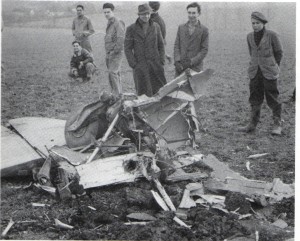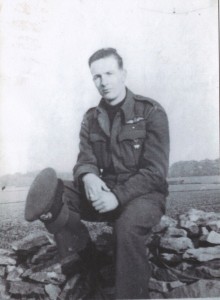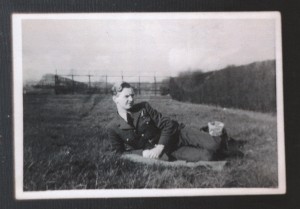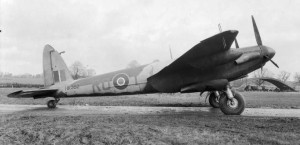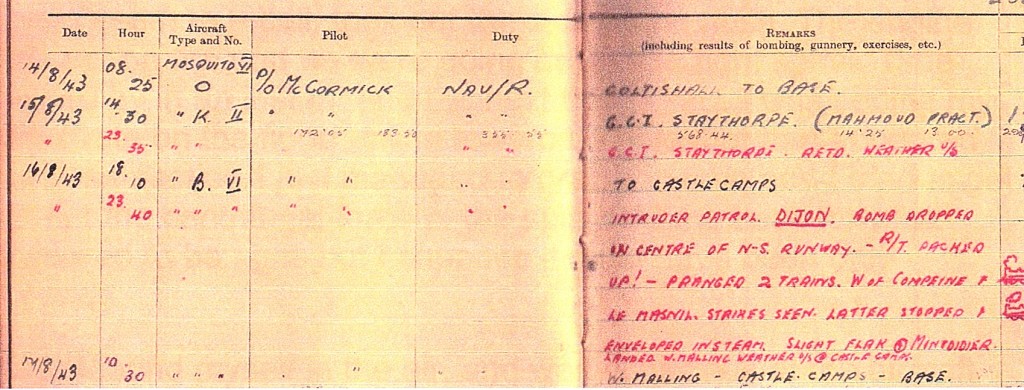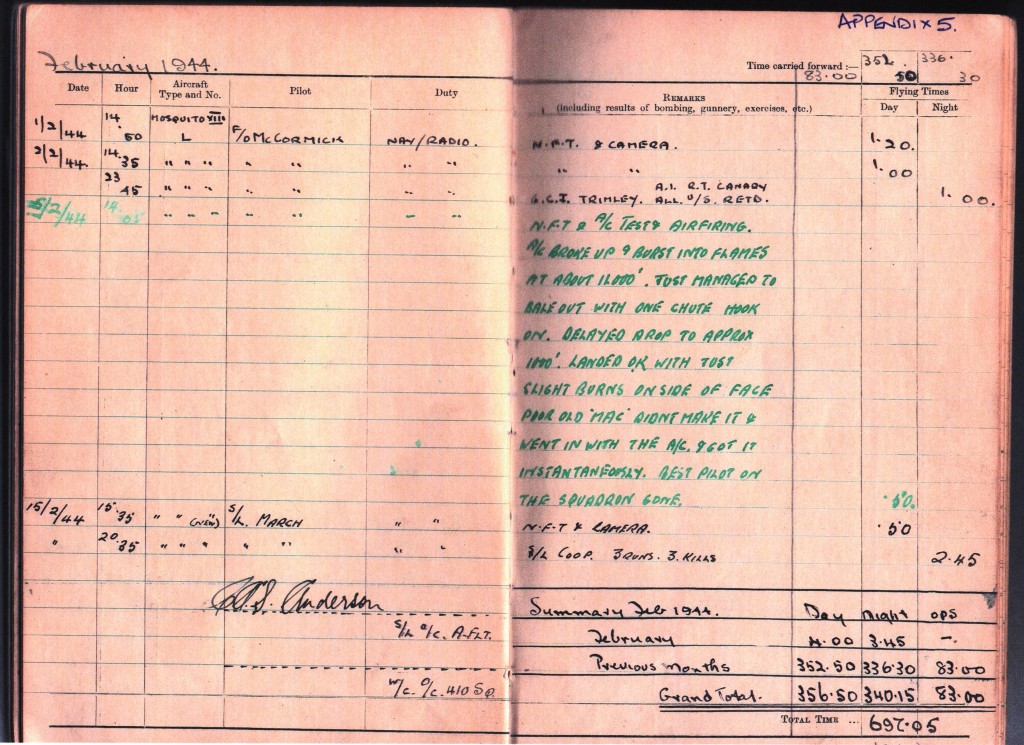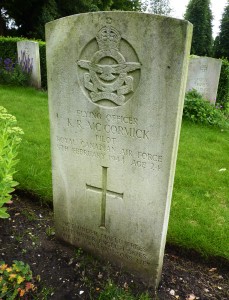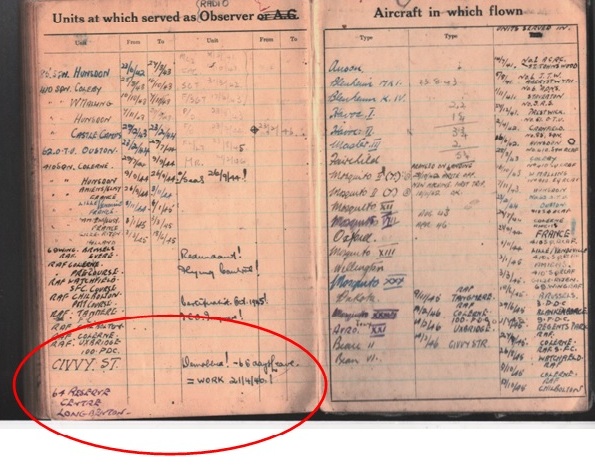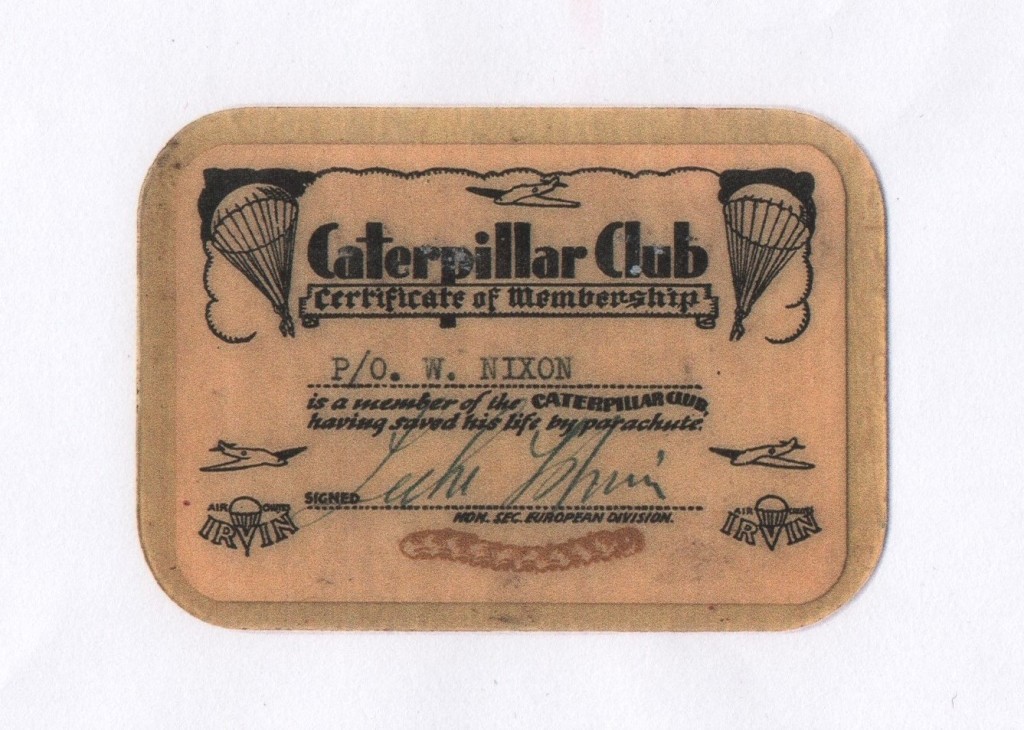On 5th February 1944, a Mosquito on a test flight crashed at the top of Tilty Hill.
Darren Stone, Chairman of Tilty Archaeology & Local History Group, has carried out extensive research on the incident. He has contributed his findings for this project, and his report is set out below. The son of Pilot Officer William Nixon (the navigator of the plane) has also kindly supplied material from his father’s records about the crash, and about his experiences with the RAF during and after the war.
At 3.00 p.m. on the 5th February 1944 a De Havilland Mosquito crashed near Tilty Church in Essex.
The Canadian pilot, Flying Officer Keith Robert McCormick, died in the crash and the RAF Navigator, Pilot Officer William Nixon, managed to bail out just before the aircraft crashed into fields just by the Tilty to Broxted road.
The picture was taken by USAF personnel from nearby Easton Lodge (RAF Great Dunmow), who were quickly on the scene; it shows the tail of the Mosquito with the large tail wheel clearly visible. The crash was witnessed by a few local residents, and service personnel from the 508th Searchlight Batallion who were stationed very nearby at Tilty.
Background and lead-up to the crash
F/O McCormick (‘Mac’) and P/O Nixon (‘Nick’) first flew together in April 1942.
They trained as a specialist Night Fighter team, firstly flying Bristol Blenheims and Havocs, and intercepted and destroyed a German HE111 bomber on 7th September, 1942. Shortly after this they converted onto the De Havilland Mosquito night fighter. They flew regularly with 85 Squadron and 410 Squadron, amassing many hours flying time, and became great friends over the course of the next few years.
The Mosquito was undoubtedly one of the greatest aircraft of the war. Known as ‘the wooden wonder’ it was deliberately constructed mainly of wood in order to save valuable metals; it was made in sections, often by furniture factories, and stuck together by new glues of the time. Although it sounds primitive, it was an amazing aircraft – and powered by two Rolls Royce Merlin engines it was one of the fastest and most capable aircraft of the war, flying as a fighter, a bomber and a night fighter. Its speed and range were not matched by any other aircraft until later in the war. The photograph below shows a Mosquito NF (Night Fighter) Mark XIII, very similar to the type that crashed at Tilty.
In 1943 Keith McCormick (known as ‘Mac’) and Bill Nixon (also known as ‘Nick’) were flying night raids into France – as Bill’s flying log book entry for 16th August 1943 shows:
The entry says that they took off from RAF Castle Camps, patrolled over Dijon and dropped a bomb on the runway there, and strafed two trains in a nearly five hour sortie.
Various types of Mosquito were flown as newer versions updated the squadrons, and by February 1944 they were flying a Type 13 Night Fighter. On 5th February 1944 both pilots were in Mosquito serial number HK454.
Here, in his own words, is F/O Nixon’s account of the flight and the crash, taken from an aircrew newsletter after the war.
‘On 5th February 1944, we took off from base (Castle Camps) to conduct an air test. As usual, we were experiencing a little trouble with the starboard engine, and climbed to about 13,000 feet to give it a full run up and test. F/O McCormick seemed satisfied with the results, saying ‘OK Nick, that’s fine, let’s go home’. He then dipped the starboard wing over and nosed down, in the way he had done so many times before, and quickly began to lose height.
For those not familiar with the layout of the Mosquito cockpit, the pilot sat forward of the navigator, who actually sat on the main wing spar, onto which the whole fuselage was lowered during manufacture. In the centre of the main spar, which ran from wing tip to wing tip, was the navigator’s bench seat, where he sat on his dinghy, which was in turn attached to his parachute harness.
Just as we had lost about two to three thousand feet, Mac was pulling out of the dive when there was an almighty bang below me. I was thrown violently onto the cockpit floor. Mac leaned over me and attempted to jettison the escape hatch, which was on the starboard side. At that point the starboard wing, outboard of the engine collapsed.
This, I seem to recall, took out the side of the nose. The engine then set on fire and we were going down in a tight spiral. Time flashed by in an instant, and the next thing I recall, was seeing my parachute on the floor, rolling towards a hole that had appeared in the nose section. I just managed to grab it in time and I tried to get out, but the centrifugal force of the spin held me back for what appeared to be ages, but I suppose it must have been only seconds.
Next, I found myself in the air, and was conscious of the aircraft falling immediately above me, on fire, raining pieces of burning wreckage on top of me.
I don’t seem to remember much after that except that somehow I must have hung onto the parachute, held on by only one strap. It seemed that soon after it opened, I hit the ground.
At this time the aircraft crashed, on fire, only a few hundred yards or so away from me.
I struggled free of the harness and ran towards the burning aircraft, but someone got hold of me, keeping me back until the accident and ambulance services whisked me away. Later, on the way to the hospital, shattered, the doctor told me that Mac hadn’t made it. Trapped in the aircraft, he did not survive.
I discovered later, when my parachute and harness were recovered, that only one parachute retaining hook had been attached to the harness. I was indeed very lucky to escape with only a few burns, but had lost a gallant pilot and good mate in the crash.
Later, the Accident Board of Inquiry was held, and I was called upon to give evidence. I stated that it was my opinion that the main wing spar had broken on pulling out of the dive. This was indignantly denied as not being possible, both by the investigators and the de Havilland representative present. They tried to imply that Mac had been undertaking unauthorised aerobatics, which, of course, I strenuously denied.
Many years later I was told by a friend, who was quite qualified to say so, that there had been similar cases of structural failure, and that the cause was found to be water seepage into the main spar, which would weaken it to breaking point.
However, I have not had this confirmed from any official source, but know that Mac was not to blame for the loss of the aircraft.
Among the conclusions of the Board of Inquiry was that an undercarriage door had become dislodged, resulting in wing failure and loss of control.’
Bill’s poignant log book entry for the day is shown below:
Bill Nixon survived the crash and, as his log book shows, was flying again ten days after the crash. He saw V2 rockets being launched on occasions in 1944, and had another ‘prang’ in November 1944 when an engine cut out and he crash-landed at Brussels. In understated style, he writes:
[W]e prepared the for landing on one engine, which meant that our approach would be much faster than usual. We managed to reach the airfield without trouble and approached at about 180 m.p.h. We got down OK, but then left the runway and ran onto the grass for several hundred yards. As we were beyond the runway lights, it was pitch black, but we were coming very slowly to a halt and breathing sighs of relief when… Bang! We had run into a shell hole on the outer perimeter. The nose dropped and we turned over, hanging upside down in our straps. We released ourselves in the dead of night, and were sent crashing down through the canopy. We were both OK, apart from a rather nasty gash on my head, which I got from the jagged perspex that had sliced through my flying helmet.
Bill continued to fly as a Mosquito navigator until he was de-mobbed in 1946, and also flew with the RAF reserve after the war.
After the Tilty crash, Bill Nixon was also made a member of the Caterpillar Club. This was an informal association of those whose lives have been saved by using a parachute to bail out of a disabled or flaming aircraft. More information about the club may be found here: http://www.51squadron.com/CaterpillarClub.html
